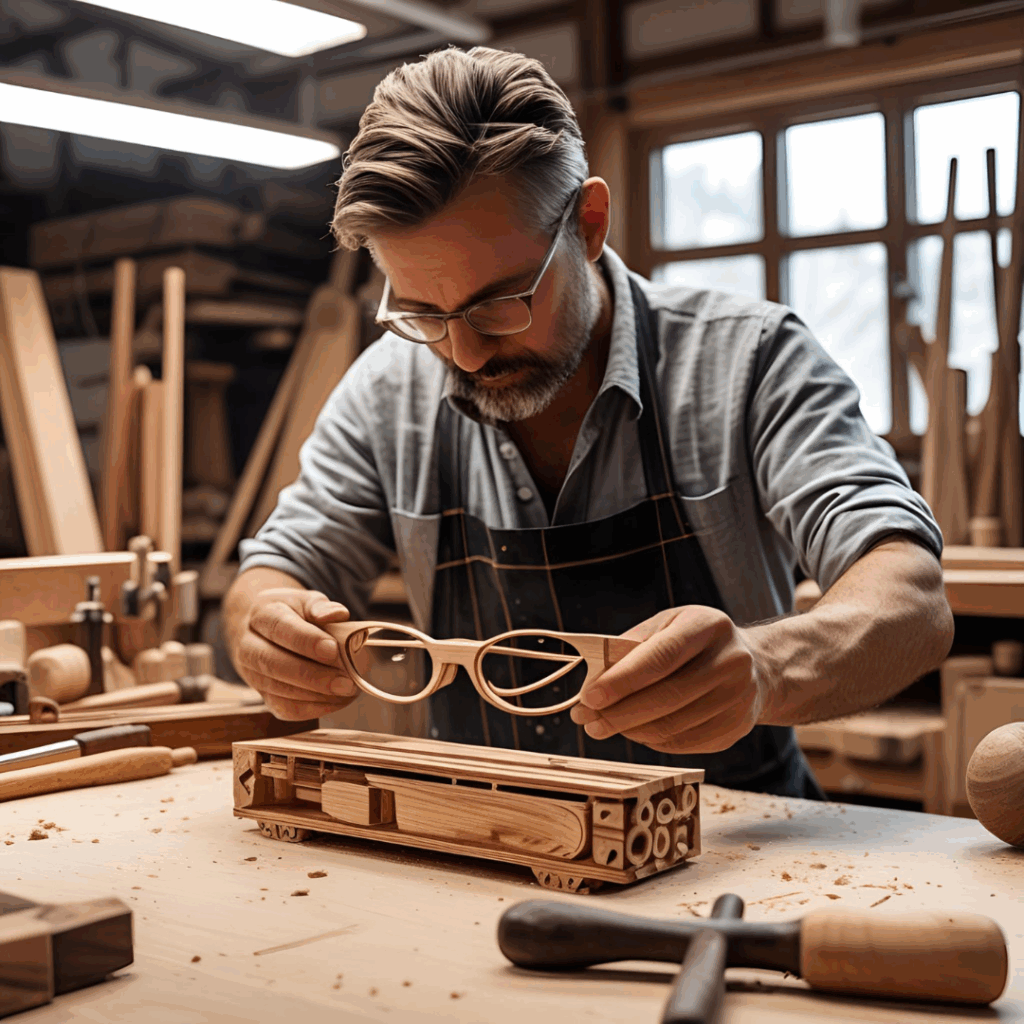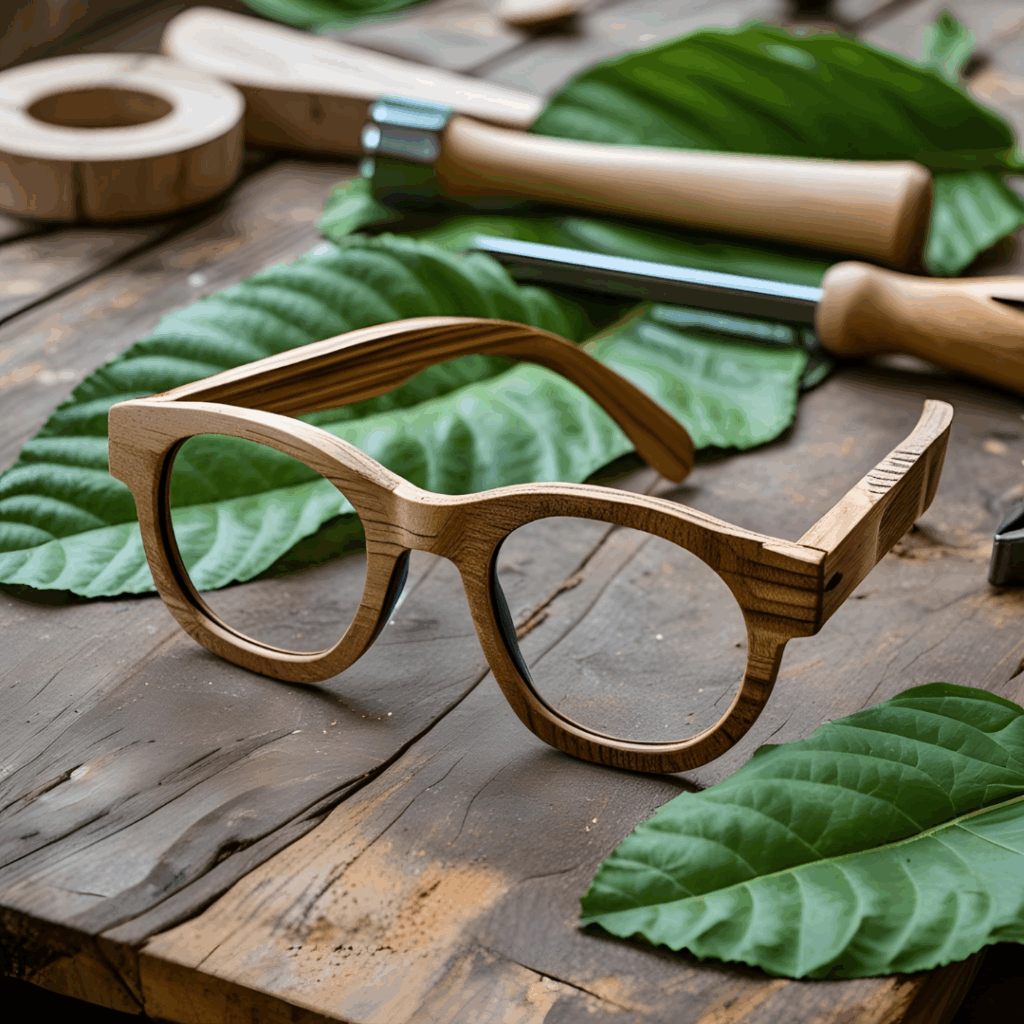Environmental awareness is revolutionizing the way we consume fashion and accessories. Among the trends gaining momentum is the use of sustainable materials to craft products, and glasses made from recycled wood stand out by combining style, durability, and respect for the environment. If you love design, enjoy handmade work, and want to be part of this green revolution, learning to create your own artisanal glasses with recycled wood can be a rewarding and profitable experience.
In this complete guide, you will learn all the steps to make your glasses—from choosing the wood to the final finishing—plus design tips, essential tools, and care instructions to ensure a quality product. Let’s get started?
Why Choose Recycled Wood to Make Your Glasses?
Using recycled wood in accessories has grown due to several advantages this material offers, especially for those looking for conscious production. Here are some reasons to choose it:
- Real sustainability: Reusing wood that would otherwise be discarded prevents deforestation and reduces solid waste environmental impact.
- Unique and exclusive: Each piece of wood has its own texture, color, and grain pattern, ensuring your glasses are completely unique.
- Durability and comfort: Properly treated wood offers resistance and feels comfortable to the touch, with a balanced weight that doesn’t tire the wearer.
- Natural style: The rustic and elegant look of wood adds value to the design, especially for those seeking a distinctive and authentic style.
- Versatility: It can be combined with recycled metals, acetate, or even technological components to create innovative designs.
Also, by choosing glasses made with recycled wood, you position yourself within a global trend of sustainable fashion that is winning over conscious consumers.
Materials and Tools Needed to Get Started
To make your own sustainable glasses, you need the right tools and quality materials. Here’s a basic list to set up your starter kit:
Materials:
- Recycled wood (pieces from pallets, old furniture, wine boxes, reclaimed wood)
- Temples (arms) for the glasses (can be made of wood, recycled metal, or reused acetate)
- Small screws and hinges specific for eyewear frames
- Varnish, natural oil, or beeswax for finishing and wood protection
- Strong, non-toxic wood glue
Tools:
- Jigsaw, precision saw, or fine hand saw
- Sandpaper of various grits (80, 120, 220, 400)
- Drill with thin bits (1 to 2 mm)
- Clamps to hold pieces during gluing
- Craft knife or scalpel for fine details
- Precision pliers
- Screwdriver for assembly
- Ruler, square, and pencil for marking
How to Choose the Ideal Recycled Wood?
Not all recycled wood is suitable for making glasses. It’s essential to select pieces with characteristics that facilitate the work and guarantee a quality final product. Consider:
- Wood condition: Avoid pieces with deep cracks, mold, termites, or warping.
- Thickness: The wood should be thick enough to create sturdy frames but not too heavy — typically between 3 mm and 6 mm.
- Texture and finish: Prefer woods with relatively smooth and consistent surfaces for easier finishing.
- Origin: Prioritize legally sourced wood, such as discarded furniture or used pallets, to ensure sustainability.
- Type of wood: Hardwoods like walnut, cherry, or even reclaimed exotic woods usually yield excellent results.
Before starting, do a simple test: sand a piece to see how it reacts to cutting and finishing.

Detailed Step-by-Step to Make Your Artisanal Wooden Glasses
1. Planning and Drawing
The first step is to define the glasses’ model. You can seek inspiration from classic designs or create something totally original.
- Draw the frame, temples, and details on paper with approximate measurements.
- Use rulers and squares to ensure symmetry and proportion.
- Consider the face shape for which the glasses are intended — round, square, aviator, cat-eye, among others.
2. Transferring the Template to the Wood
With the drawing ready, transfer the template to the wood using a pencil and ruler.
- Draw carefully to avoid cutting mistakes.
- If preferred, print templates and glue them on the wood for greater accuracy.
3. Cutting the Frame and Temples
Use the appropriate saw to cut the pieces.
- Go slowly to avoid splinters or breaks.
- If the wood is very hard, make partial cuts in stages to facilitate the process.
- Use a mask and safety glasses for protection.
4. Sanding and Initial Finishing
Sand all edges and surfaces to remove burrs and ensure comfort.
- Start with coarser sandpaper (80-120) and move to finer grits (220-400).
- Pay special attention to areas that will touch the skin.
5. Drilling for Hinges and Assembly
Using the drill and a thin bit, make precise holes to fit screws and hinges.
- Make sure to align the holes correctly between the frame and temples to guarantee proper movement.
- Make pilot holes to avoid cracks.
6. Assembling the Pieces
Use screws and hinges to attach the temples to the frame.
- Tighten carefully to avoid damaging the wood.
- Use wood glue on the joints for reinforcement.
- Use clamps to hold until the glue dries completely.

7. Final Finishing
Apply varnish, natural oil, or beeswax to protect the wood and highlight its natural beauty.
- Use a brush or soft cloth to spread evenly.
- Wait for the recommended drying time.
- If desired, apply more than one coat for greater protection.
Design Tips to Make Your Glasses Unique and Modern
- Material contrast: Mix light wood with aged metal or colored recycled acetate temples.
- Laser engraving: Personalize with patterns, logos, or even names on the temples for an exclusive touch.
- Incorporate natural elements: Add small details with stones, seeds, or recycled metals.
- Different finishes: Explore varied textures, from super smooth polishing to matte rustic finishes.
- Multifunctional glasses: Combine with prescription lenses or high-quality sunglasses lenses.
Maintenance and Care to Extend Your Glasses’ Lifespan
To preserve the beauty and functionality of your recycled wood glasses, follow these recommendations:
- Avoid prolonged exposure to water and moisture to prevent warping.
- Clean with a dry, soft cloth, avoiding harsh chemicals.
- Reapply oil or wax every 6-12 months to keep the wood hydrated and protected.
- Store in a hard case to prevent impacts.
- Avoid leaving glasses exposed to intense sunlight for long periods, as heat can dry the wood.
How to Turn Your Hobby into a Sustainable and Profitable Business
Making sustainable glasses can become a source of income if you know how to position yourself in the market:
Fair Pricing
- Calculate the cost of materials (even recycled, consider the cost of tools and supplies).
- Consider the time spent on production.
- Add margin for profit and possible marketing and sales costs.
- Compare with market prices to adjust your offer.
Sales Channels
- Sustainable fashion and local craft fairs.
- Collaborative stores and eco-friendly boutiques.
- Online platforms like Etsy, Elo7, Shopee, and Instagram.
- Partnerships with independent eyewear shops and local designers.
Marketing and Branding
- Tell the story behind the handmade and sustainable production.
- Show the creation process with photos and videos on social media.
- Use recyclable packaging and communicate your environmental commitment.
- Seek feedback and testimonials to build customer trust.
Environmental and Social Impact of Recycled Wood Glasses
Besides creating exclusive and beautiful pieces, you contribute directly to:
- Reducing solid waste: Reusing wood that could be discarded.
- Decreasing natural resource exploitation: Reducing demand for new wood.
- Promoting the circular economy: Encouraging reuse and extending the lifecycle of materials.
- Generating income and skills: Potential for courses and workshops involving local communities.
This approach creates a virtuous cycle where design, environmental awareness, and value creation go hand in hand.
Making your own sustainable glasses with recycled wood is an amazing way to combine creativity, environmental responsibility, and entrepreneurship. With the right techniques, accessible materials, and some dedication, you can create exclusive accessories that not only beautify but also tell a story of respect for the planet.
Enjoy experimenting, innovating, and, above all, sharing this passion for sustainability with more people. The future of fashion lies in conscious hands — and yours can start with a simple pair of glasses.







